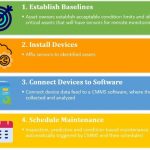Fault tree analysis (FTA) is used to establish a potential chain or path of equipment failures using Boolean logic to generate a graphical relationship of events leading to part or system failure. It is a deductive approach that is useful for different systems or facilities at the product design or operational stages. FTA fosters reliability of systems by: [Read more…]
Articles tagged CMMS
Invest in Food Manufacturing CMMS

From demonstrating compliance and ensuring safety to maintaining assets and increasing productivity, food manufacturing maintenance managers have their work cut out for them. Thankfully, computerized maintenance management software (CMMS) can streamline processes and improve maintenance operations for the food manufacturing industry. Read on to learn how food manufacturing CMMS software can significantly benefit your organization.
[Read more…]Most Commonly Underused CMMS Features

Want to achieve a worthwhile return-on-investment (ROI) from your software? Then it’s important to learn about some of the most commonly underused computerized maintenance management system (CMMS) functions. Many organizations do not use all of the features their preventive maintenance software provides, or don’t use the functions to their full capacity. In fact, a majority of plant maintenance managers feel they aren’t using their preventive maintenance software to its maximum capability.
Modern-day CMMS systems are crammed with various features, and users don’t necessarily need to access and master every feature of the system. However, it becomes a problem when users get so comfortable with their way of doing things that they avoid features they’re not familiar with. Especially if those features could potentially improve their productivity. Understanding what impact underutilized CMMS functions can have on your maintenance department will help you make the most of your software.
How To Use CMMS To Supplement Root Cause Analysis
According to the American Society of Quality (ASQ), a root cause is defined as “A factor that caused a nonconformance and should be permanently eliminated through process improvement. The root cause is the core issue—the highest-level cause—that sets in motion the entire cause-and-effect reaction that ultimately leads to the problem(s).”
As most of you already know, Root Cause Analysis (RCA) is a systematic process for identifying the origins, or root cause, of problems and determining an approach to minimize or eliminate their risk of recurrence. It focuses on preventing problems at the source rather than resorting to a firefighting approach and being reactive every time. RCA tries to be more scientific about asset failures, going one step beyond troubleshooting. [Read more…]
What is Maintenance Workflow?

Maintenance workflow is the step-by-step process that gets initiated by some trigger event to the point where the action is closed out. For example, in a typical maintenance operation, a trigger event could be a report of faulty equipment. The step-by-step workflow process would include the generation of a maintenance order, the planning of the task, the execution of the repair and the reporting at the end of the job. Every organization has a workflow process whether it is officially documented or not; there is always a standard way to get things done. When this process is not well-defined, it can lead to frustrations on the part of employees trying to get their jobs done as well as major inefficiencies that are costly to the organization over time. In comes maintenance management software…
Cloud Based CMMS vs On-Premise

Is your organization best suited for a cloud based CMMS or on-premise maintenance software? As the price of bandwidth and storage continues to decrease, cloud-based maintenance software is becoming an increasingly popular choice. Many cloud-based CMMS/EAM software vendors are pushing this technology as a convenient and cost-effective alternative to traditional, on-premise software, but cloud-based solutions aren’t necessarily right for everyone. There is no such thing as a one-size-fits-all solution, so you would be better off exploring the pros and cons of cloud-based vs on-premise CMMS options before committing to any particular technology. [Read more…]
5 Ways To Reduce Your Overall Maintenance Workload
Maintenance of different equipment within a facility remains a core enabler of improved productivity and efficiency of plant processes. Poor maintenance practices lead to machine downtime, increased operational costs, and increased maintenance workloads.
Reducing maintenance workload can’t be done overnight, but it is a goal worth pursuing. Less maintenance work performed (without an increase in reactive maintenance work) means less resources spent – fewer spare parts used, less overtime work, and improved employee satisfaction that can actually increase the average quality of performed maintenance work.
5 Ways To Improve Reliability Of Performed Maintenance Work
Improving the reliability of performed maintenance work helps in the refinement and improvement of policies that shape a cost-effective maintenance strategy that aims to address dominant causes of asset failure.
Before we continue, we have to define how reliable maintenance looks like. In the context of this article, we will define it as consistently performing adequate maintenance in the required time frame. In other words, it means performing good maintenance work while respecting due dates.
Using CMMS In FMEA Process
At first glance, a computerized maintenance management system (CMMS) and Failure Modes And Effects Analysis (FMEA) may appear to be worlds apart. But take a deeper dive, and it’s easy to see that they both share a common component: data. The core of any CMMS is defined by gigabytes of data that guarantee its usefulness and functionality, while the success of the systematic steps in FMEA depends on good quality data.
Combining CMMS with Remote Asset Monitoring for World-class Maintenance

The biggest change in asset management practices and maintenance models in the coming years will be the shift from corrective and preventive to predictive and condition-based maintenance that is built on real-time as well as historical data.
With emerging new technologies like IoT (Internet of Things) and easy access to the Internet and cloud storage capabilities, accessibility to information and remote monitoring of assets can be done anytime and from any location and device. This calls for a reliable remote monitoring setup accompanied by a robust and proven management system to track and manage all that data. And it is this combination precisely that can elevate your business to a world-class maintenance program.
How to Streamline Emergency Maintenance with a CMMS
Emergency maintenance is the maintenance required when an asset suffers an unexpected functional failure. Typically, such failures can halt production lines and disrupt business operations until fixed.
Emergencies almost always happen without prior warning, and hence emergency maintenance is not one that can be preemptively scheduled – but it can definitely be planned for and efforts made to reduce its business impact when they do occur.
Maximizing Routine Maintenance Efforts With A CMMS

Your facility asset and equipment are first and foremost a significant organizational investment. Performing routine maintenance on them is a key aspect of maintaining them in functioning order. Nothing will risk derailing production like an unexpected catastrophic failure of critical equipment – and one of the best ways to prevent that is to develop a robust routine maintenance strategy for your assets.
How to Use CMMS to Improve OEE and TEEP

Overall equipment effectiveness (OEE) is a widely implemented metric that characterizes the performance of a plant, and is expressed as a percentage of the total planned or scheduled production time. OEE essentially measures your plant’s performance in terms of equipment reliability and availability. It is calculated as the product of 3 factors – performance, quality, and availability:
Benefits of Manufacturing Maintenance Software

Maintain equipment, minimize downtime, meet production demands, manage inventory levels, monitor staff productivity, comply with regulatory standards, etc. etc. The list of maintenance demands in a manufacturing plant is nearly impossible to meet without the help of computerized maintenance management systems (CMMS). Manufacturing CMMS software automates the process of maintaining assets to help simplify operations, maximize uptime and control costs.
Many manufacturing plants are relying on outdated systems or maintenance spreadsheets to keep tabs on their equipment and other important aspects of production. In doing so, they run the risk of premature equipment failure, production lags, increased downtime and, ultimately, the loss of business. Consequently, competitors utilizing modern manufacturing CMMS software are more successful.
How To Improve Wrench Time (Measurement) With A CMMS

As the owner or maintenance manager at a busy organization, one of your priorities will be to monitor the efficiency of your maintenance team to sustain that level of efficiency (if it’s satisfactory), or improving it (if it’s below an acceptable level). Doing this will require that, among other things, you understand what’s really going on while staff are on the job and then identify any areas for improvement.

 Ask a question or send along a comment.
Please login to view and use the contact form.
Ask a question or send along a comment.
Please login to view and use the contact form.